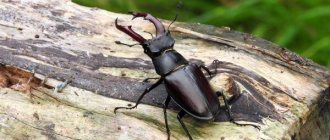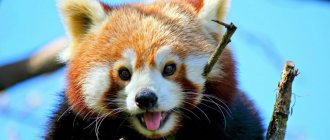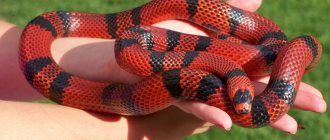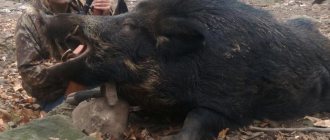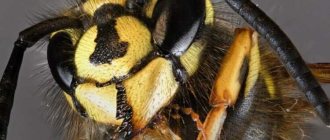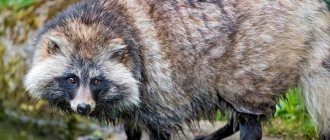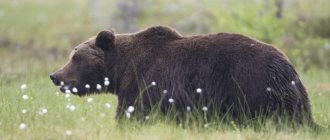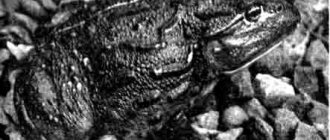Who is the red panda?
Unfortunately, the animal is listed in the Red Book as an endangered species. According to various sources, there are 2,500-10,000 individuals left on the planet. This animal has few natural enemies; the main problem is deforestation where this species lives. No less dangerous are poachers who destroy animals for luxurious fur. The fire fox reproduces well in captivity, zoos around the world are trying to restore the population, but the situation remains precarious.
origin of name
The first official name of the red panda - Ailurus fulgens - was given by the Frenchman Frederic Cuvier. However, earlier this type of fauna was discovered by Thomas Hardwig and suggested calling the animal “ua”, as the red animal sounds like. The fiery fox began to be called panda from the Nepalese “punya”. The name firefox is not justified, the animal is not related to foxes, until recently its closest relative was a raccoon, but this information was denied. Many years ago, the dwarf and giant panda shared a common ancestor, both species are classified in the family Ailuridae.
Where does it live?
The red panda lives in China, Nepal and northwestern India. Animals prefer highlands and live at altitudes from 1500 to 4800 m above sea level. Animals do not like sudden changes in temperature; they need moderate climatic conditions - they cannot tolerate not only cold, but also heat. Temperatures above 30 ºC are fatal. The ideal temperature is from 17 to 25 ºC.
Many years ago, the habitat of the dwarf panda was much wider. Remains are found in Eastern Europe and North America. There is an assumption that these places once had a suitable temperate climate, and a change in the climatic picture of the world greatly narrowed the boundaries of the species’ habitat and brought it to those protected places where this little bear can still be found in nature.
In all areas of its natural habitat, the animal is exterminated, someone catches the cubs for taming and domestication, in the Chinese province it is believed that hats made of panda fur at weddings bring happiness to newlyweds. The animal also acts as the mascot of the international tea festival in the Indian city of Darjeeling.
- Russians can receive benefits and payments without certificates
- French manicure with gel polish
- VISA will link store bonuses to your cards
Kinds
The red panda has characteristics of the Ailur genus. They are characterized by a combination of several features taken from different animals - skunks, martens, bears and raccoons. This suggests that its genus belongs to the primary form from which today's canids and marten-like animals descended.
All other Ailur species, including the great red panda, have become extinct. According to archaeological data, they lived over a large territory of Eurasia and America. Fossils are still found in Siberia to this day.
Nowadays there are 2 subspecies:
- Red panda Staiana;
- Western red panda (pictured).
The first subspecies lives in the north of Myanmar, in the southern regions of China. The second is in Nepal, Bhutan. That is, one of them belongs to the northeastern habitat region, and the other to the western one.
Description of the red panda
The dwarf panda resembles a small fox, a raccoon and a cat at the same time. It is small, the weight of males varies from 3.7 to 6.2 kg, females are more miniature - up to 6 kg. Body length – 51-64 cm . The tail is long and strong, up to half a meter in length, which, in addition to its aesthetic component, carries a functional load. With its help, the “bear” climbs trees perfectly.
The body of the animal is elongated, the muzzle is short, dark brown beady eyes and a black, dog-like nose stand out. Paws are strong and stable. The claws are long and sharp, especially on the front paws, which only this species of panda can partially retract, like cats. The head is large due to well-developed jaws with wide teeth. The fire fox has 38 teeth!
Features of color
When you mention “little panda,” everyone imagines the teacher of the black and white clumsy cartoon bear, a kung fu master. However, in nature, the fiery fox is even more beautiful, thanks to the brightness and shimmering shades of its luxurious fur coat. The body of the fire cat is covered with thick fur, the color of which is truly unique, partly referring to classic pandas, but with individual differences.
The main color of the back and head is from light walnut to red. The color looks especially impressive due to the ticking of the coat. Each hair is darker at the base and very light towards the tip, hence the beautiful tints. The light muzzle is almost beige, there are also light circles around the eyes, the pattern is unique for each animal. Paws are dark brown. And the tail deserves special attention. It is red, but with narrow rings of a more intense color, resulting in a striped raccoon tail, which refers the subspecies to raccoons.
Afghan fox
A resident of the Middle East and Afghanistan is the Afghan fox. It is not afraid of hot climates; it is found in the driest places of the mountains. This representative of the fox family is small in size, dull in color, and has a long tail made of thick fur. The length of her tail is equal to her body. This is a small breed. Foxes grow up to 30 cm in height, no more. Weight can vary from 1.5 to 3 kg.
The animal is distinguished by a small, graceful head and a short, pointed muzzle. This is a breed of fox with large ears. Moreover, the latter are not only an excellent organ of hearing, but also a heat sink in hot weather. In different places of residence, the color of the animals varies from light brown to almost black.
The Afghan fox's diet differs from that of other species. Its diet includes not only rodents and insects, but also plant food. These chanterelles do not form permanent pairs; they come together only for the mating season. The female takes care of the offspring, while the male sometimes only guards the den. The fertility of this species is low: no more than three cubs are born.
Lifestyle in nature
In the wild, the brown panda is predominantly nocturnal; during the day, the animals sleep in tree branches or in the hollow of a tree. Animals hide there in case of danger. Most of the life of these animals is spent in trees; here they are agile thanks to the long claws and tail with which they hold onto the trunks. On earth, the “fiery fox” is funny, touching and sometimes clumsy.
Habits and behavioral characteristics
Animals live in pairs or populations, together. They even have their own language . The animals “talk” using funny chirps. They have a peaceful character. But these miniature bears mark their territory - both in the traditional way and with the help of glands located on the pads of their paws. Males bravely defend “their” zone, and when a competitor appears, they hiss, stand on their hind legs and nod their heads threateningly to frighten the enemy.
- Redevelopment of Moscow apartments can only be approved online
- How to insulate plastic windows
- How to extend speed on Beeline
What does a dwarf panda eat?
Fire cats are predators. However, in reality they are vegetarians and practically do not consume animal food. The basis of the diet is young leaves and shoots of bamboo - these gourmets choose the softer shoots. But the animal’s stomach is simple, like that of predators, and not multi-chambered, like that of herbivores. Therefore, a small part of what is eaten is absorbed. The little animal has to eat for days on end to store up energy. Another 5% of the diet consists of berries and mushrooms; the animal can eat bird eggs and even hunt small rodents.
Korsak
You can see a representative of this fox species in the photo below. As you can see, the corsac dog is similar to a red fox, only its fur is not as rich in color. Representatives of this species of foxes are smaller in size and have large ears. The animal has a pointed and short muzzle. The fox has a white belly and a light chin. A photo of the Corsac fox breed demonstrates this. The end of the tail is brown or black. In winter, a gray coating appears on the animal’s spine. The animal's fur changes length with the seasons. In summer it wears a short coat, and in winter it wears a warmer coat with pubescent fur.
This species of fox lives in the southern and eastern parts of Europe and Asia. Corsac loves steppes and deserts with little vegetation. For this feature it is called the steppe fox. For housing, they use other people's holes of badgers, marmots, gerbils and other foxes.
The corsac comes out to hunt at night. It feeds on rodents, reptiles, insects, and birds. Sometimes its diet even consists of carrion and various waste. He does not eat plant foods. This breed of foxes has a very interesting trick - pretending to be dead. This is how she deceives people. The corsac breeds like an ordinary red fox.
Reproduction and raising offspring
The mating season for the animals falls in January. mate only once a year. During this period, males become very active, intensively marking trees with the help of urine and special glands. Females are also interested in searching for a male, because the period suitable for fertilization lasts up to a day and occurs only once a year. It is necessary to take advantage of the opportunity presented, because the animals quickly find a common language.
After conception, the fetus develops within 50 days, but the raccoon panda often paces. Pregnancy lasts 90-145 days; it is impossible to say more precisely how long it will take before the babies are born. At the beginning of pregnancy, there are latent periods when fetal development is slowed down. In a litter, the number of cubs is 1-2 puppies, less often up to 4, but only a few survive to adulthood. The cubs are called puppies, they weigh 110-130 grams, like newborn kittens.
For the first couple of weeks, the puppies live in the population with their mother, curled up in a tight ball in the nest, where the female warms and feeds the puppies. Baby pandas open their eyes on the 18th day . After this, the female begins to remove the puppies from the nest and adapt them to independent life. Later, babies are offered solid food, but milk feeding continues until 5 months. Then each cub lives and moves with its mother for up to a year.
Lifespan
On average, a fire panda lives from 8 to 10 years. However, there are nuances:
- In captivity, in zoos, with proper living conditions, an appropriate diet and the absence of natural enemies, life expectancy increases and red cats live up to 14-15 years.
- The centenarian is registered in the American zoo; he lived for 19 years.
- In private hands as a pet, the lifespan is greatly shortened due to difficulties in care.
Number of red pandas and captivity
The orange panda is listed in the Red Book. According to various sources, there are up to 10 thousand individuals left on the planet. However, the mini panda thrives in captivity. 350 animals are registered in 85 zoos around the world , which reproduce well in an artificial environment. But the population is recovering very slowly, the red fox gives birth only once a year, and the litter usually contains 2 puppies.
Is it possible to tame the Fire Fox?
Unfortunately, domestication of red pandas as pets is practiced in India and Nepal. Not only is this blasphemy towards an endangered species, but it is also very difficult to create favorable conditions for the life of an animal at home, because the life expectancy of such pets is sharply reduced. To preserve this species on the planet, it is necessary to abandon the idea of purchasing such a pet. It's better to admire these cute creatures in zoos.
Amazing breed: fox cat
Many readers are interested in these cats and why they look so much like foxes. We are talking about a long-haired Somali cat, or Somalia. The sight of this beauty takes your breath away. She has large ears, a fluffy collar, and “pants” on her hind legs. The fox cat has a muscular body. The color of these cats can be different, but the fiery red beauty looks the most luxurious.
The fox cat has an easy-going character, she is obedient, and gets along well with her owner. Somalia loves to rummage through cabinets, drawers, and play with water. During the day, such pets often sleep. Owners need to keep in mind that the curiosity of these cats can lead to damage to valuable things, because such pets, like foxes, are very active and rush around the house.


